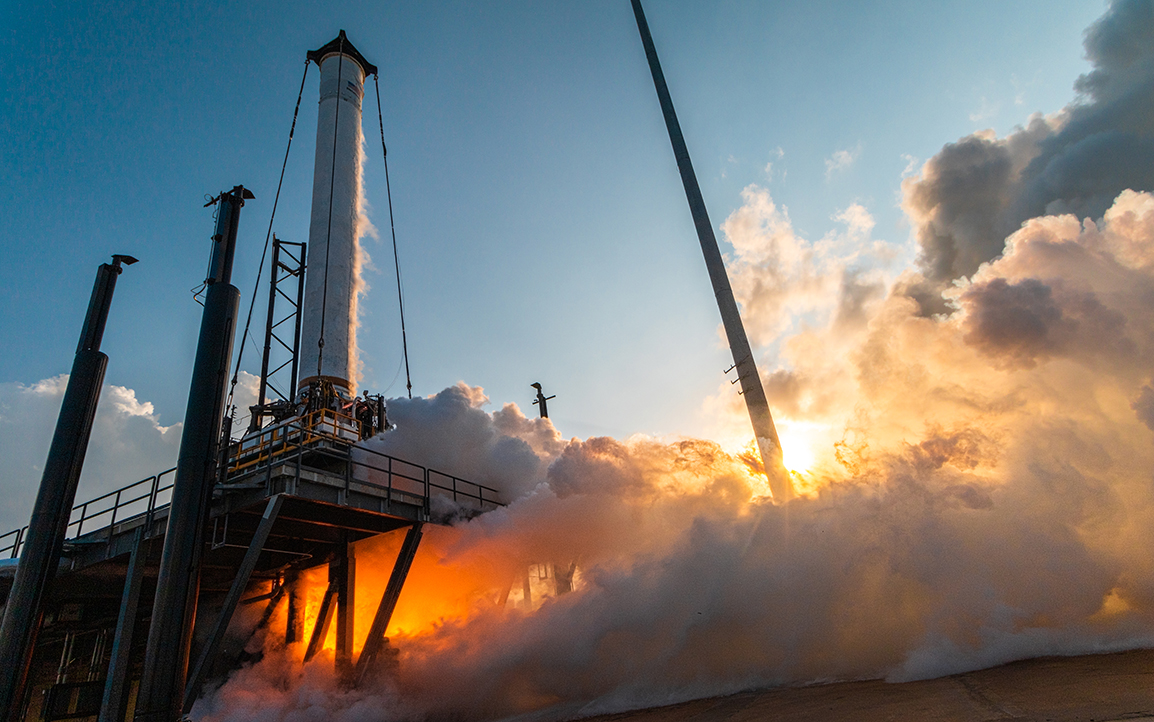
Additive Manufacturing Subtracts from Rocket Build Time
Subheadline
NASA teamwork on 3D printing and testing engines makes company's launch services more affordable
Speed is everything in rocketry. To get into low-Earth orbit, a spacecraft needs to hit velocities around 17,000 mph. And any company building a commercial rocket must have it designed, built, tested, and flying payloads as fast as possible to begin recouping the astronomical cost of reaching commercial readiness.
For the last decade or more, even as it’s been finalizing its own heavy-lift rocket, NASA has also been adding to the nation’s launch fleet by helping several commercial space companies reach that finish line. And some of them are accelerating their journey by unconventional means.
Most recently, after about five years of cooperative efforts with NASA, Relativity Space’s Terran 1 rocket became the first 3D-printed rocket to reach space during a March 2023 launch. The company aims to use its rockets to offer affordable rides into space for commercial satellites and other payloads.
Under a series of Space Act Agreements, Relativity has worked closely with engineers at NASA’s Marshall Space Flight Center in Huntsville, Alabama, on developing rocket engines built with 3D printing, also known as additive manufacturing. And the company has been testing those engines at the agency’s Stennis Space Center in Bay St. Louis, Mississippi.
“NASA has certainly helped accelerate the progress we’ve been making across propulsion, across test and launch infrastructure, and in the flight of our vehicles,” said Scott Van Vliet, current advisor and former senior vice president of software engineering, avionics, and additive manufacturing at Relativity, which is based in Long Beach, California. Additive manufacturing, he said, has helped the company speed its development in part by combining the design and build phases.
The Terran 1 rocket was 85% 3D printed by mass, with the body built by Relativity’s Stargate printer using what the company calls wire arc additive manufacturing. But printing the engine took some help from NASA.
Saving Time Is Saving Money
Compared to other parts of the vehicle, “a rocket engine has the longest developmental lead time and comes with the most risk because of the extreme environments and manufacturing challenges,” said Paul Gradl, principal engineer of component development at Marshall. “It’s operating from cryogenic all the way up through 6,000°F and at very high pressures, pushing the materials to their limits.”
Gradl has been leading NASA’s research into 3D printing engine components and working directly with Relativity and other companies to get that technology out into the private sector.
Every week, a team of Relativity engineers meets virtually with Gradl and his team to discuss the company’s progress and share ideas, said Jake Shearman, senior manager of combustion devices at Relativity. He noted that Marshall constantly generates new information about 3D printing materials and design, helping the company stay abreast of the state of the art. They also occasionally meet in person to let the NASA engineers take a look at Relativity’s latest hardware and offer input, he added.
Gradl also helped the company incorporate a copper-chromium-niobium alloy that NASA invented, known as GRCop-42, which has proven especially adaptable to additive manufacturing.
He noted that NASA has invested millions of tax dollars into this research and wants to do as much as possible to make the resulting data and expertise available to U.S. companies. “It’s a huge benefit for NASA and commercial space to infuse these technologies and work collaboratively toward common mission requirements.” And Gradl said partnerships like this help the space agency stay on top of the challenges facing the commercial space industry and work on solutions to those challenges.
NASA has been interested in additive manufacturing because it offers the opportunity to produce and test parts faster, in addition to performance benefits. What used to be 200 pieces welded together can now be printed as one or two solid parts. “And with that, I think the biggest advantage is the cost and schedule savings,” said Gradl. “We are able to reduce the lead time of some of these parts by two to 10 times, and with that comes a huge cost savings.”
Relativity likewise benefits from the ability to produce higher-performance engines, but Van Vliet said the short lead time for producing new parts is also the biggest advantage the company gets from 3D printing because it allows engineers to quickly zero in on optimal designs.
“When you look at a traditional approach to building rockets or engines using traditional systems of casts and molds and dies and tooling to manufacture things, you have to have a decision around the design of the vehicle or the part or component locked in way ahead of time,” said Van Vliet. But with a 3D printer, instead of rebuilding the assembly line to make a change, “we can just make changes in CAD, print the part, treat it, and send it back to the test stand.”
Trials by Firing
Those test stands are at Stennis, where Relativity has agreements to use a number of test sites. For example, the company is doing extensive testing in a cell of the center's E Test Complex, which is made to evaluate small engines and high-pressure components.
“Being able to utilize the facilities that NASA’s already built at this Stennis facility has put us leaps and bounds ahead,” said Clay Walker, Relativity’s senior director of test operations.
Shearman agreed. “The E1 test facility has given us the opportunity to get earlier data on our innovative approaches, so we can try new techniques and kind of play in the sandbox without being burdened by the arduous process and longer lead time of building large stand infrastructure.” And that’s just where the company is testing engines now. “As Relativity has grown and our engines have grown, we’ve basically just been leapfrogging between all of the test stands,” Shearman said.
Now the company is building its own test complex on 150 acres at Stennis, which is one of NASA’s largest field centers, giving it a large buffer area between engine firings and the nearest homes and businesses.
Most of the testing facilities Relativity and others use at Stennis aren’t getting a lot of use from NASA, as the space agency’s testing needs change, so leasing them out makes sense for everyone, said Duane Armstrong, manager of the Stennis Strategic Business Development Office. He noted that companies also often buy access to other infrastructure and commodities available onsite, such as pressurized propellants or cryogens. “All of those things lead to a cost-sharing arrangement that’s beneficial for everybody. It covers some of our maintenance and operating costs, and it provides quality services for industry.”
Everyone’s a Winner
Ultimately, Armstrong said, NASA has a long-term goal of fostering commercial space companies like Relativity, from whom the agency hopes to one day purchase affordable launch services.
“In the end, they’re getting better performance and lower costs, which means we can potentially fly our payloads and astronauts safely and at a reduced cost on some of their missions,” Gradl agreed. “We help enable this commercial space economy, and then we can take advantage of it and free up some of our resources to do some of the more difficult missions, returning to the Moon and eventually on to Mars.”
NASA and the company also hope to learn from each other as they work toward 3D printing Relativity’s planned, massive Aeon R engine, said Shearman. The Aeon 1 engine that powered the recent Terran 1 launch was built with an additive manufacturing technique known as powder bed fusion, which works well for small engines but hits limitations as engine size increases, he said. Aeon R is planned to have more than 10 times the thrust of its predecessor.
“As other 3D printing technologies gain in maturity – and NASA has honestly been leading a lot of that – we look forward to figuring out how you scale up in size,” said Shearman. “It’s something that has not yet been conquered by the aerospace industry for additive technology.”
By the time of its launch in March 2023, Relativity had already sold $1.2 billion in contracts for flights on Terran 1, with customers including OneWeb and Intelsat. The company later announced it would move directly to developing the larger Terran R rocket, with many of those contracts likely transferring to the new rocket.
“From my point of view, additive manufacturing allows us to deliver payload services and launch services at a better price point,” said Van Vliet. “And it allows us to integrate the most state-of-the-art technologies because we’re able to make design choices along the way.”
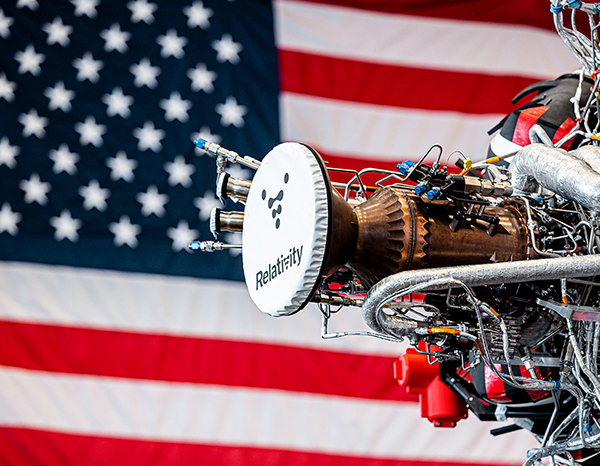
Relativity Space worked with engineers at Marshall Space Flight Center for several years to refine the 3D printing of its Aeon 1 rocket engine, incorporating a copper alloy that NASA had invented. Credit: Relativity Space Inc.
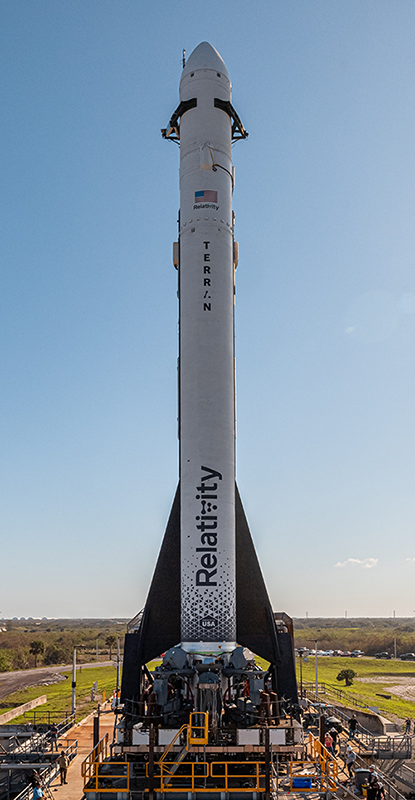
Relativity Space’s Terran 1 rocket sits on the Launch Complex 16 launch pad at Kennedy Space Center. Credit: Trevor Mahlmann
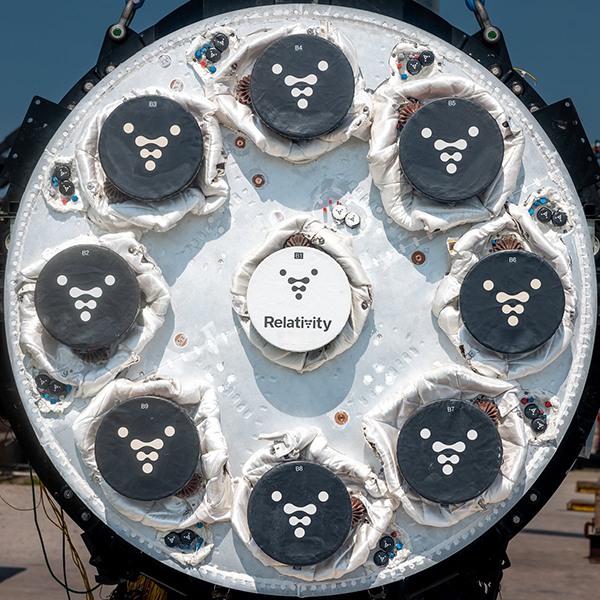
Nine Aeon 1 engines fill out the business end of the first stage of Relativity Space’s Terran 1 rocket. The engines were built and tested with help from NASA. Credit: Relativity Space Inc.
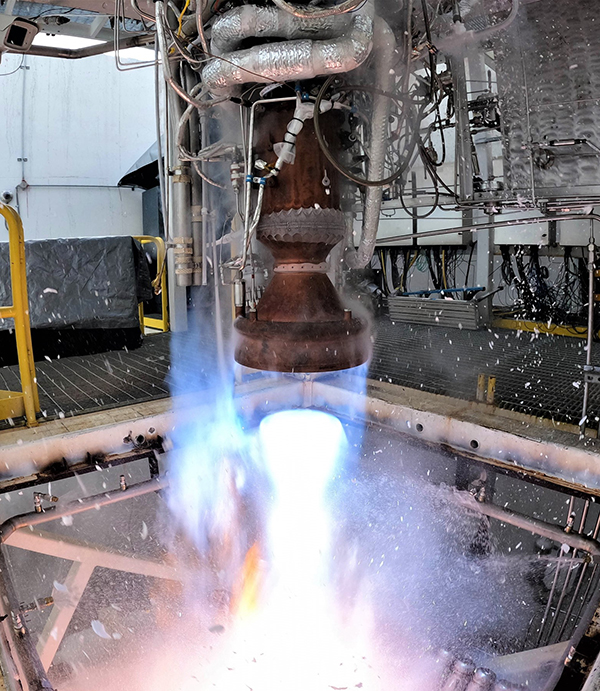
One of Relativity Space’s 3D-printed rocket engines undergoes hot fire testing on Stennis Space Center’s E4A test stand. The company leased a number of engine-testing facilities at the center, where it is now building its own test stands. Credit: Relativity Space Inc.
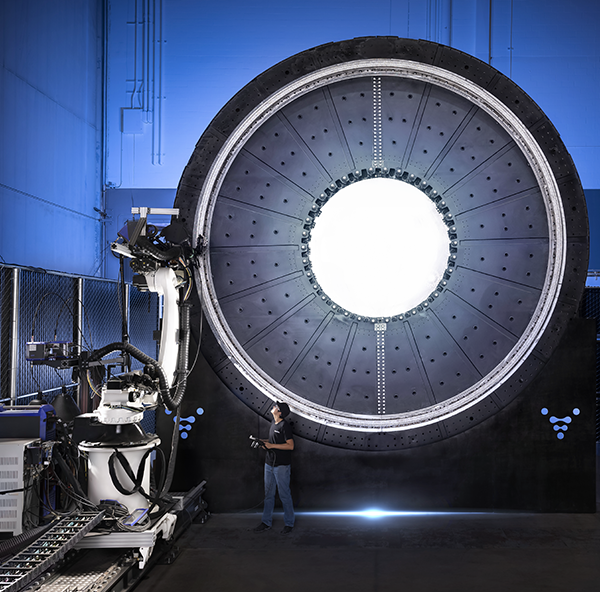
Relativity Space is using its fourth-generation Stargate metal 3D printer to build the body of its rockets. The Terran 1 rocket that launched in March of 2023 was 85% 3D printed by mass, including its body and engines. Credit: Relativity Space Inc.

The first stage of Relativity Space’s Terran 1 rocket undergoes an 88-second hot fire test at Stennis in September of 2022. Credit: Relativity Space Inc.













